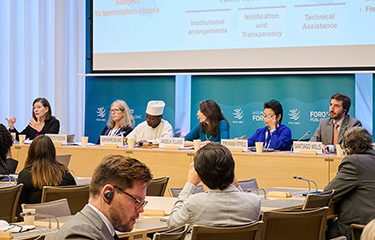Members of the World Trade Organization will shortly elect a new chair to handle the next phase of talks to end harmful fishery subsidies with an informal meeting of delegates taking place 10 October, where participants will map out a course for negotiations.
Santiago Wills, Colombia’s ambassador to the WTO, chaired the negotiations on the landmark agreement struck in June 2022, which prohibited subsidy support for illegal, unreported, and unregulated (IUU) fishing and limited fishing of overfished stocks. In a statement in late September, Wills urged WTO members to deposit their instruments of acceptance of the agreement as soon as possible so to allow it to enter into force. Hesaid work would continue on “advancing the negotiations” in preparation for the upcoming conference of trade ministers in December 2023.
With a low-key leadership style, Wills garnered credit for stewarding the June agreement to approval, as besides the limitation of subsidies, it added requirements for transparency on subsidy payments and created a fund to enable capacity training for least-developed nations in implementing the agreement. But the accord was also criticized for not ending subsidies that have led to overcapacity of fleets and overfishing.
Eduardo Pucci, director of Argentina-based fisheries conservation body Organización para la Protección de los Recursos Pesqueros en el Atlántico Sur (OPRAS), was one of numerous representatives from coastal nations calling for improvements to the deal.
“I think that the agreement reached in the WTO is insufficient and lacks the necessary penalties that do not depend on the relation between the flag-state itself and its vessels,” Pucci told SeafoodSource. “However, it is a step forward at a conceptual level. Remote fishing on straddling species, [illegal, unreported, unregulated] fishing, or fish without rules on the high seas will continue.”
Europêche Managing Director Daniel Voces, representing Europe’s fishing sector, specifically called out incentives recently offered by provincial and local governments in China for the construction of fishing vessels and for transportation of distant-water catches back to their home ports. Zhangzhou, Xiamen, and Fuzhou each offer generous subsidies to local distant-water fishing companies, and in September, the southern Chinese city of Shenzhen began offering generous subsidies for tuna-vessel purchases and catch returns.
“We are worried about how China is using subsidies,” Voces said. “It seems to be incentivizing overcapacity and overfishing, rather than fostering sustainable fisheries and the conservation of marine resources.”
As he has done previously, Voces defended subsidies given to European vessel owners for their operation.
“These [Chinese] incentives or subsidies have nothing to do with those being offered to E.U. fleets,” he said. “In fact, under Article 13 of the new European Maritime, Fisheries and Aquaculture Fund, the construction, acquisition or importation of new fishing vessels is not eligible for public funding in the E.U. Besides, investments and compensation for the fleet in the E.U. are very restrictive – particularly for vessels over 12 meters – and strictly conditional upon their consistency with the conservation objectives of the E.U.’s common fisheries policy.”
By contrast, explained Voces, “fishing vessels operating under the framework of E.U. fisheries agreements with third countries are normally requested to land at least part of the catch in the third country’s fishing ports and part of the catch is directly commercialized in that region not in Europe.”
China’s subsides have taken on more weight as freight rates for frozen reefers doubled between 2020 and 2021, according to veteran of the tuna industry in Asia and the U.S.
“Freight rates have been remarkably slow to decline, despite the small ebb in fuel prices. The earning reports of the shipping lines show their rewards. Also, containers were hard to get, and in some places remain that way.”
The payments offered by Shenzhen are “capacity-enhancing subsidies in nature, lowering capital and operational costs of the vessels, particularly those that fish beyond Chinese jurisdictional waters,” explained Ernesto Fernández Monge, who works on The Pew Charitable Trusts’ Reducing Harmful Fisheries Subsidies project.
“This could lead to overfishing in the high seas and other countries exclusive economic zones,” he told SeafoodSource. “This is the reason why it is important for the WTO Agreement on Fisheries Subsidies to enter into force as soon as possible so members will have to think about the sustainability of the resources when granting subsidies.”
Negotiators are expected to aim their next round of talks at enhancing the agreement so it effectively curbs payments that lead to fleet overcapacity and overfishing. However, subsidies for transporting catches back to China may not even be covered by an improved WTO fishery subsidy deal, according to Monge.
“There are different types of subsidies under these schemes, including vessels construction, transporting fish, and tax incentives that could fall under the definition of the new WTO agreement as long as they are for fishing and fishing-related activities at sea,” Monge said. “There are others, like air freight and inland infrastructure, which might not fall with the scope of the WTO fisheries subsidies agreement – however, it is important to note that current Agreement on Subsidies and Countervailing Measures could apply to them.”
Photo courtesy of World Trade Organization







